
17 minute read
Stay Safe: Fly Privately

You probably already know that flying privately is an unrivalled travel experience. This year, though, perhaps more than ever before, we’re all realising just how clearly private aviation is the safest way to travel too.
Advertisement
Naturally, you want to protect yourself, your family, your friends and your colleagues from the threat of COVID-19. Why take any unnecessary risks?
Here are nine reasons to fly in a private jet, not just now but for years to come:
1. No queues. Move quickly through a spacious, dedicated business aviation facility, rather than pushing past strangers in a crowded airport terminal or airliner. Commercial aviation simply isn’t designed for social distancing. The number of touchpoints exposing passengers to the risk of contagion when travelling on any airline is dramatically higher than on a business aviation flight. Even when crisis measures ease, the long-term ‘new normal’ will almost certainly involve more extreme medical caution and checks at airports than before the pandemic. Checks mean queues. Don’t be surprised if commercial airline travel becomes increasingly time-consuming and frustrating.
2. You can choose your fellow passengers. Fly with relaxed confidence, knowing your inflight ‘bubble’ is a healthy group.
Destination Unlocked
3. Airlines are in chaos.
The airline industry has been devastated by coronavirus. Some of the damage will be irreparable. The streamlining and restructuring needed to survive will surely see some direct city-pair connections disappear and frequencies fall. You’ll be forced to take more connecting flights than ever before, which means waiting around busy terminals, heightening your risk of contagion (especially when the inevitable delays and cancellations occur). A private jet will simply take you directly where you want to go, whenever you want to fly. And if you’ve become comfortable enjoying first-class airline travel, now might be the time to start enjoying the even more luxurious pleasures of private aviation. Airline service levels, by necessity, have fallen to minimise interaction between crew and passengers. And the first-class cabins will disappear entirely when some airlines, streamlining to survive, remove larger aircraft such as the Airbus A380 and Boeing 747 from their fleets. Airlines just can’t match private jets for service and flexibility.
4. Rigorous health measures, on the ground and in the
air. Sanitisers, gloves and masks are provided for all our staff, passengers and crew at Luxaviation Group, both in the ground handling facilities and on the jets. We operate strict regimes for cleaning and disinfecting aircraft. We use anti-pathogen agents (which kill and inhibit viruses and bacteria) to complete a full sanitisation cycle before and after every flight. Has air quality ever mattered more than now? Many private aircraft are fitted with high-efficiency particulate air (HEPA) filters, which means you and your travelling companions will be safer (and, importantly, feel safer too) from the risk of virus infection in a business jet than an airport, office, shopping centre or car. And don’t worry – although our crews are as friendly as ever, we won’t be shaking your hand at the moment!

5. Comprehensive, expert advice. A well-informed global management company and operator will be able to tell you everything you need to know about the latest destination and passenger restrictions. In this complex and rapidly changing regulatory climate, you’ll receive all the help you need to secure the correct travel approvals and paperwork (such as your travel history) for your journey.
6. Value. You might be pleasantly surprised when you realise there isn’t necessarily a big price difference between private jet and first-class airline travel…but the private jet experience leaves airlines far behind.
7. The flight can be part of a wonderful package. Right now, we’re being called all the time by luxury resorts and hotels across the world offering safe, highly personalised and exclusive breaks from secluded cottages to island paradises. These companies, understandably, want our services to be sure their guests will be travelling safely. There’s no point booking a break in secure isolation if you’ll need to push through crowds to get there.
And if you’re not sure where to go next, take a look at ‘Luxaviation Experiences’. You’ll find incredible, highclass breaks from African safaris to European cultural tours.
8. You can take ownership of your travel experience,
literally. If you want total control of your flying environment, consider buying a jet ahead of chartering. A top-class management company will be able to support you through the process.
9. You can add a helicopter and yacht to your travel
portfolio. Would you like the ultimate in a controlled, end-to-end travel experience, minimising the risk of social contact and shared spaces? Why take a taxi to the marina when you can fly a helicopter straight onto your yacht?
As we all move through these unprecedented times, health and peace of mind feel more important than ever before. There’s no safer, more relaxing way to travel than private aviation.
Wakatipu Heights. Property QBS11986.



Bits of Glitz
TIFFANY & CO. CEMENTS ITS LEADERSHIP IN DIAMOND TRACEABILITY

Tiffany marks an industry first by sharing the full craftsmanship journey of its individually registered diamonds
Last October, Tiffany & Co. took an unprecedented step in diamond traceability by sharing the full craftsmanship journey of its newly sourced, individually registered diamonds (0.18 carats or larger). Disclosing the country where each stone is crafted and set in jewelry marks an industry first. This follows the 2019 announcement that Tiffany would become the first global luxury jeweler to provide the provenance (region or countries of origin) of its individually registered diamonds. By taking transparency to a new level and sharing the full craftsmanship journey of its diamonds, Tiffany reinforces the brand’s commitment to ensuring that every step in the journey of its products contributes to the well-being of people and the planet.
“Today we advance our commitment to diamond traceability one step further,” said Anisa Kamadoli Costa, chief sustainability officer, Tiffany & Co. “Our customers deserve to know that a Tiffany diamond was sourced with the highest standards,
not only in quality but also in social and environmental responsibility. We believe that diamond traceability is the best means to ensure both.”
A diamond’s region or countries of origin, along with where it was cut and polished, graded and quality assured, as well as set in jewelry, will be shared with Tiffany customers for each newly sourced, individually registered diamond. This information will be available from any sales professional as well as printed on the Tiffany Diamond Certificate. Tiffany continues to lead the industry by bringing a new level of transparency to its diamond supply chain. The brand is unique among global luxury jewelers in owning and operating five of its own diamond polishing workshops around the world. This is where nearly 1,500 Tiffany artisans ensure excellence of cut is obsessively considered to maximize brilliance, dispersion and scintillation – not just carat weight. With Company owned diamond workshops in Belgium, Mauritius, Botswana, Vietnam and Cambodia, as well as a Tiffany Gemological Laboratory in New York and five jewelry manufacturing workshops in the North America, Tiffany can ensure its own superlative standards are met.
“Sharing the craftsmanship journey of Tiffany diamonds reflects decades of investment in our supply chain,” said Andrew Hart, SVP Diamond and Jewelry Supply, Tiffany & Co. “Directly sourcing responsibly mined rough diamonds, and crafting and setting those diamonds to our standards in our own workshops, is unique to Tiffany among luxury jewelers.”
Offering this degree of supply chain transparency, which is without equal among global luxury jewelers, sets Tiffany apart and is made possible by the 20+ year investment in vertical integration. This vertical integration model helps uphold standards of craftsmanship, safe and healthy working environments, community economic development and supply chain traceability. Together with the philanthropic endeavors led by The Tiffany & Co. Foundation, which has granted $85M over 20 years, Tiffany & Co. has been a pioneer in sustainable luxury.
Bits of Glitz
THE STEPS IN A TIFFANY DIAMOND’S CRAFTSMANSHIP JOURNEY
STEP 1: Responsible Sourcing
Many Tiffany diamonds begin their journey as responsibly sourced rough stones from trusted suppliers, mined in countries such as Australia, Botswana, Canada, Namibia, Russia and South Africa, and prohibited from areas of concern such as Zimbabwe and Angola. Since January 2019, Tiffany has been disclosing the provenance (region or countries of origin) of its individually registered diamonds to consumers, a first among global luxury jewelers.
STEP 2: Preparation & Planning
All of the diamonds Tiffany sources as rough stones continue their journey in Antwerp, Belgium. Here, each individual diamond’s origin is recorded, and then the diamond is sorted for size, color, clarity and florescence, before its unique design is mapped.
STEP 3: Cutting & Polishing
Tiffany cuts and polishes diamonds with great accuracy and artistry at workshops in Mauritius, Botswana and Vietnam, Cambodia as well as Belgium. Tiffany owned or approved diamond cutting and polishing facilities offer safe and healthy work environments; and adhere to health and safety standards that, in many places, go above and beyond local laws. In its workshops, Tiffany is proud to hire locally, invest in communities, and provide a living wage for employees in developing countries. Tiffany also procures select polished diamonds from trusted suppliers who comply with its traceability, quality, social and environmental standards.
STEP 4: Grading & Quality Control
Tiffany diamonds are meticulously evaluated at the network of Tiffany Gemological Laboratories in the U.S., Cambodia, and Vietnam, ensuring every stone meets superlative grading requirements, standards which are established and assured in New York.
STEP 5: Setting
Finally, Tiffany sets the majority of its diamonds at Tiffany workshops in the U.S. A diamond setter pairs each unique diamond with its ideal, individually crafted setting to showcase the beauty of the stone, requiring great accuracy and artistry. Tiffany workshops meet high standards for safety, cleanliness and a productive, welcoming environment.
STEP 6: Tiffany Blue Box
A Tiffany diamond is now ready to be placed in its Tiffany Blue Box® and bag, made with paper from sustainable sources, including FSC®-certified and recycled materials. For more information on The Diamond Craftsmanship Journey and Tiffany’s sustainability efforts visit Tiffany.com/sustainability
Bits of Glitz

NEW TWENTY~4 WATCHES BY PATEK PHILIPPE
A new face for the Twenty~4, the Patek Philippe ladies’ watch born to accompany every moment of the modern woman’s life
The manufacture is stepping up the allure of its Twenty~4 collection exclusively for women with a fresh interpretation of the original “manchette” or cuff-style quartz model in steel of 1999. It is launching two new versions adorned with white-gold applied Arabic numerals and white-gold applied trapeze-shaped hour markers. Designed as stylish companions to every facet of an active lifestyle, these Twenty~4 references 4910/1200A- 001 with a blue sunburst dial and 4910/1200A-010 with a gray sunburst dial stand out more than ever as paragons of timeless feminine elegance. Since 1839, timepieces for women have always featured prominently in Patek Philippe’s collections – whether as the pocket watches or pendant watches of the nineteenth century or the wristwatches that first emerged in the early twentieth century. Several milestones in the manufacture’s history also relate to watches destined for women, such as the first true wristwatch made in Switzerland, created for a Hungarian countess in 1868, and the Geneva company’s very first striking wristwatch, a five-minute repeater housed in a small platinum case with an integrated chain bracelet in 1916.
A modern classic
In 1999, Patek Philippe strengthened its privileged links with feminine watch lovers by launching its first
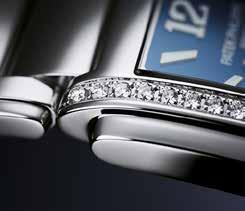
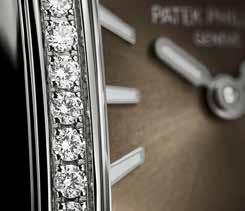
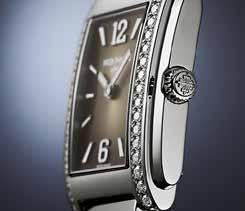
Bits of Glitz
collection dedicated exclusively to women. The aim was to meet the demands of the independent active woman who sought a timepiece with an assertive personality able to adapt to her modern lifestyle. A watch of timeless elegance that would complement her fashionable business wear and most elegant evening wear. It would be her ally on every occasion, uniting contemporary design, technical excellence and impeccable craftsmanship.
Conceived, as its name suggested, for every hour of the day and night, at work, at home and during leisure activities, the new Twenty~4 stood out by its original art-deco-inspired “manchette” or cuff design, featuring a cambered rectangular case that followed the contours of a woman’s wrist and a metallic bracelet that felt exceptionally smooth and comfortable.
The first three Twenty~4 models of 1999 (references 4910/10A) were also distinguished by their pairing of steel with diamonds, an association unique at the time, with the precious stones set in two rows highlighting the rectangular shape of the two-tier case. The dials, adorned with the two applied Roman numerals XII and VI and diamond hour-markers, offered a choice of three colors: “Forever Black”, “Eternal Gray” and “Timeless White”. An elegant modern advertising campaign marked the launch of this new women-only timepiece, with the slogan “Who will you be in the next 24 hours?” shining the spotlight on the watch’s versatility. The creation of the Twenty~4 strengthened women’s perception of Patek Philippe as a brand of direct relevance and appeal to them. It reminded them that the manufacture developed and built not only the most technically innovative and complex timepieces but those most aesthetically striking and refined.
A great success
Blessed with its strong identity and a design tailor-made to live the lives of modern discerning women, the Twenty~4 quartz “manchette” model was a great success from the start and has established itself in the last two decades as one of the manufacture’s best-sellers. Over the years it has appeared in rose gold and white gold, with other dial colors (brown and blue), in a small format complementing the medium-size models, on satin straps, in dazzling Haute Joaillerie versions (including two endowed with manually wound mechanical movements) and in a yellow-gold model without diamonds on the case. Now seen as epitomizing the classic modern style, the Twenty~4 has represented, for many women, their right of entry into the Patek Philippe universe. It has consolidated the manufacture’s position as a major player in the women’s watch market and paved the way for the expansion of other women’s lines, such as the Calatravas, as well as the complications that are useful in everyday situations (the Annual Calendar, the time-zone watches and the chronographs) and even the grand complications (perpetual calendar, split-seconds chronograph and minute repeater).
The time of the Twenty~4 Automatic
In 2018, Patek Philippe responded to women’s increasing interest in mechanical watches by launching the Twenty~4 Automatic. While its bracelet retains the same exclusive design, with the broad, gently cambered central links framed by delicate two-tier outer links, this Reference 7300, endowed with a caliber 324 S C self-winding movement, stands out from the quartz-driven “manchette” model by its round case, its bezel lit with a double row of diamonds in a “dentelle” (lacework) setting, and the applied Arabic numerals



Bits of Glitz
on the dial, these last providing a distinctly contemporary note. This model is available in steel and in rose gold, with a choice of dial colors, and in a jewelry version with gem-set crown, lugs and bracelet. Patek Philippe also produces an Haute Joaillerie model in rose gold, paved throughout with diamonds, showcasing the “random” or “snow” setting. The launch of this new incarnation of timeless feminine elegance was accompanied by an advertising campaign that excited widespread interest. It gave center stage to a “Twenty~4 woman”: independent, sure of her taste and making her own way in the world.
New Twenty~4 references 4910/1200A-001 & 4910/1200A-010
Patek Philippe is continuing the renewal of its Twenty~4 collection by reinterpreting the original model, the medium-size (25.1 x 30 mm) quartz “manchette” watch in steel. It is issuing two new versions in which the Roman numerals give way to the white-gold applied Arabic numerals 12 and 6 and the diamond hour markers are replaced by applied trapeze-shaped hour markers, also in white gold. This new face constitutes the first major change to the Twenty~4 of 1999 – and an aesthetic evolution in step with the design of the Twenty~4 Automatic. The two new references feature a dial decorated with a blue sunburst (4910/1200A001) or with a gray sunburst enriched by a gradation to black at the periphery (4910/1200A-010). Their whitegold applied numerals and hour markers and whitegold baton-style hands all have a luminous coating ensuring excellent legibility in the dark. The fine grooved rays of the sunburst emanating from the center of the dial play with the light, lending a refined but dynamic touch.
The distinctive shape of the two-tier rectangular case is underlined by two rows of 18 Top Wesselton Pure diamonds (approx. 0.42 ct) set with textbook precision. A Calatrava Cross, emblem of the Patek Philippe manufacture, embellishes the crown. The supple, comfortable bracelet, fitted with a fold-over clasp, is a jewel in its own right. Each component is manually finished and fully polished. The Patek Philippe caliber E15 quartz movement is made with the same devotion to fine workmanship as the manufacture’s mechanical movements. The new references 4910/1200A-001 and 4910/1200A-010 with Arabic numerals replace the previous references 4910/10A-001, 4910/10A-010, 4910/10A-011 and 4910/10A-012 with Roman numerals.

“Rituals of my Life”
The launch of these two new Twenty~4 models is accompanied by a digital communication campaign addressing modern women sure of their taste, with an affinity for beauty and fine design. They are independent women, living life to the full, with a range of interests. Patek Philippe chose as central theme “Rituals of my Life”: the precious personal moments that punctuate the modern woman’s life – such as the finishing touches before an evening out; a pause for a moment’s serenity at sunrise; or the luxury of taking time for herself by reading a book or performing the movements that bring her physical and mental wellbeing. Essential, intimate moments that are part of a woman’s life today and that some choose to feature as scenes to be shared with friends on the social media. The slogan “Begin your own tradition” underlines the link with the famous Patek Philippe “Generations” campaign by inviting the Twenty~4 woman to begin a long-term relationship with a brand that shares her values. The images and videos work together with a film describing the creative philosophy behind the Twenty~4 collection: a model of timeless design that has become a modern classic and the gold standard for the “manchette” watch. All of which is set to strengthen Patek Philippe’s increasing success in the ladies’ watch segment and in the hearts of women for whom style and beauty must pass the test of time.

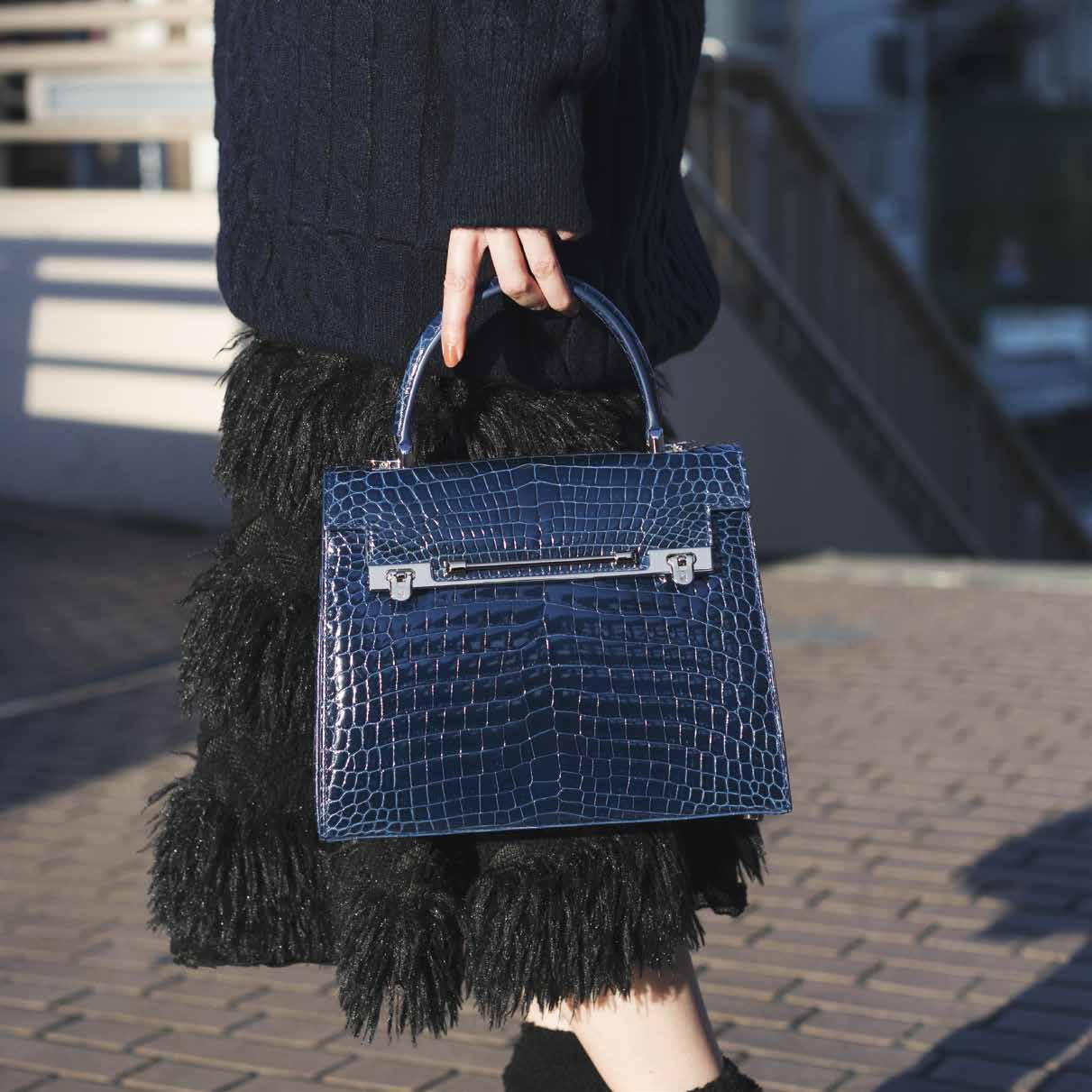

L U X U R Y G I F T I N G
PERSONAL AND LUXURY...
Whether
P E R S O N A L A N D L U X U R Y. . . you would like to send
a personalised silk scarf as a gift to one successful woman or reward your VIP clients, DELPHINE GENIN has a corporate gifting ooer that will suit you.
...CORPORATE GIFTING
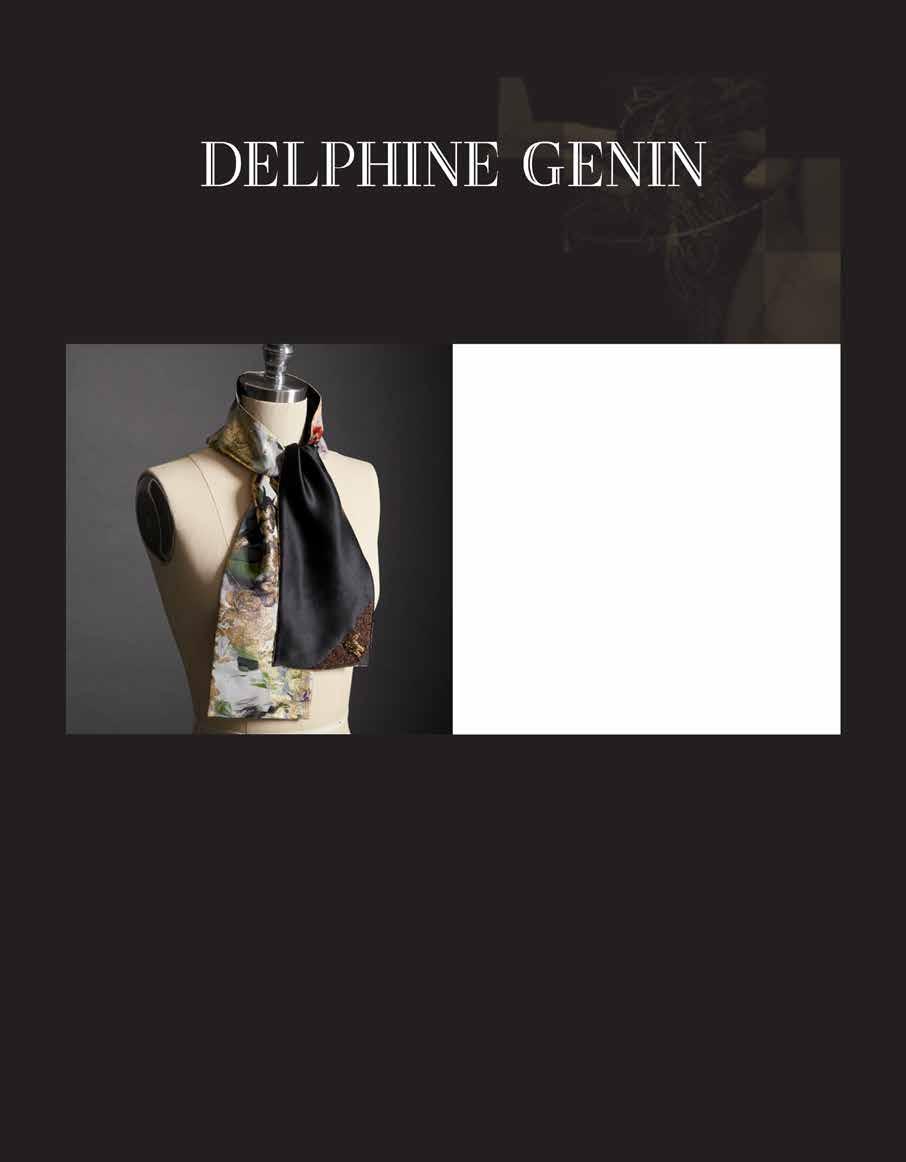













We know what our clients like when it comes to rewarding an employee or showing appreciation for a long-term relationship with a client or friend.
SILK SCARVES GIFT
Using the most expensive and rare fabrics in the World.
PERSONALISED GIFT
Custom your scarf to include your client or friend’s initials.
EVENT & GROUP GIFTING
Limited-edition pieces to reflect the theme of your company.
+61 (0)385 790 356 INFO@DELPHINEGENIN.COM DELPHINEGENIN.COM











